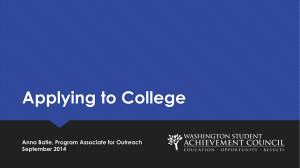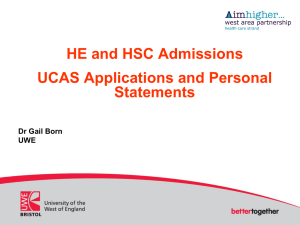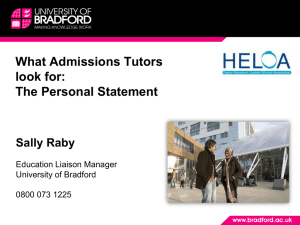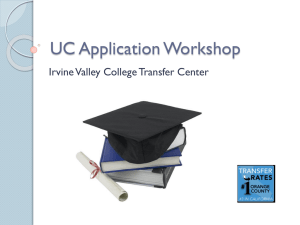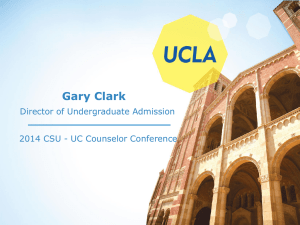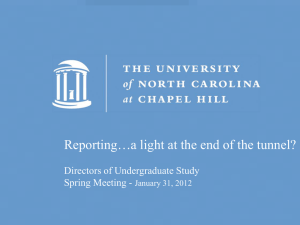student
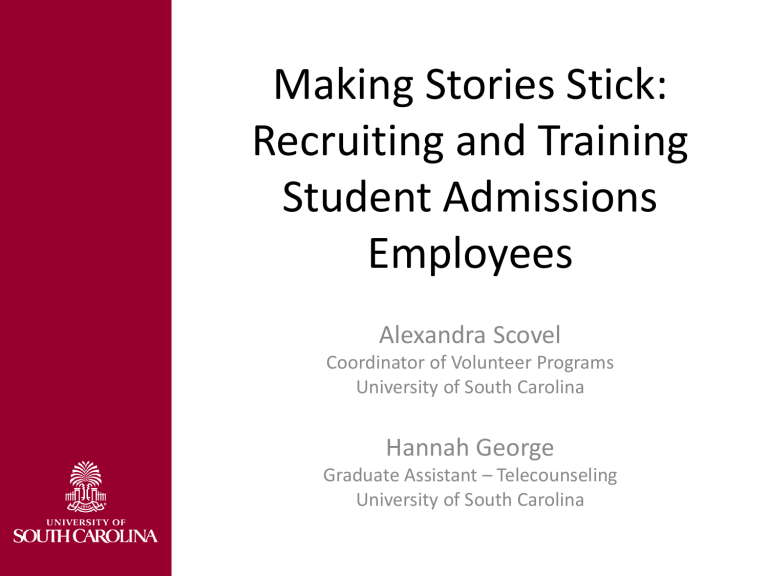
Making Stories Stick:
Recruiting and Training
Student Admissions
Employees
Alexandra Scovel
Coordinator of Volunteer Programs
University of South Carolina
Hannah George
Graduate Assistant – Telecounseling
University of South Carolina
Purpose
1. Recruiting & Hiring
2. Training & Retaining
3. Triton Training Theory: Helps offices design specific training activities that benefit student
workers, employers and the university as a
whole.
Undergraduate Admissions
University of South Carolina
• Alex Scovel
Coordinator for Volunteer Programs
• Hannah George
Graduate Assistant for Telecounseling &
Recruiting
University of South Carolina
Columbia campus: 4-year, Public, Research, Flagship
Enrollment: 22,556 undergrad; 30,721 with graduate & professional
Fall 2011 Freshman stats
• 21,000+ applications 4,569 enrolled
• IQR: SAT 1110-1270 ---ACT 24-28---Weighted GPA
Avg. 3.76
Fall 2011 Transfer stats
• 4,505 applications 1,961 enrolled
Since 2001, applications have increased 91%, and enrollment in the freshman class has increased 52% and the average SAT score has improved by 81 points.
OUR WORKING MODEL
TELECOUNSELING
What is Telecounseling?
• 28 students making purposeful calls to prospective students as part of recruitment.
• EMAS = CRM Database
• Types of calls include…
- Campus Visit/No Campus Visit Calls
- Student Outreach Calls
- Congratulatory Calls
- High School Private Visit Calls
Nightly Schedule
5:00-5:15 p.m. Attendance
• Announcements
• Calling Agenda
– Who are we calling?
– Purpose of call
– Review “Script”
– Questions/Comments
• Training activity (if campus presentation)
5:15-7:00 p.m. Begin Calling
• Pre-call planning must be part of every call
7:00-7:15 p.m. 15 minute dinner break
7:15-8:45 p.m. Icebreaker & Resume Calling
• Training activity (if in-house presentation)
8:45- 9:00 p.m. Wrap-up
• Write personal notes and prepare mail
• Hand in notes about calls
History of USC Telecounseling
• Fall of 2005
• Main goals were to increase applicant yield by building relationships and communicating important information at the right time.
• Desired outcomes included assessing student interest in the institution, communicating action items, and tracking campaign results.
• No CRM database = lots & lots of paper
Recruiting
Hiring
Training
MAKING IT STICK
Initial Approach
• Recruitment & Hiring
- Who will work for us?
- In-person interviews
• Training
- How to call and follow the call-script
- Challenging Topics
- Once at the start of each semester
Approach Now
1. What are we trying to accomplish?
- Starting with the end in mind
2. Who can help us accomplish our goals?
- Targeted Outreach
- Campus Partnerships
- Word of Mouth, Reputation, & Retention
3. Application & Interview Process
- Selectivity
The Change:
How can we do this better?
• Always asking WHY?
- Student Development Theory, why not us?
- Learning Outcomes = Better Assessment!
- Continuous training
- Goal setting, feedback loops, guest speakers, coaching, etc…
- “An Appreciative Approach to Training
Undergraduate Admissions Student Workers”
Triton Training Theory
©
Three-Pronged Approach
• Benefits to student – personal knowledge gained from training
• Benefit to employer – student feels valued, is better trained to assist customers
• Benefit to university, admissions, prospective students – knowledge of resources
Theoretical Framework
1. Appreciative Advising
– Disarm, Discover, Dream, Design, Deliver, Don’t Settle
2. Astin’s Theory of Student Involvement
3. Kolb’s Theory of Integrated Learning
– Active Experimentation
– Concrete Experience
– Reflective Observation
– Abstract Conceptualization
Examples
TRAINING IN ACTION
Examples
• Triton Training model used for all of our trainings
– Student Stories Training
– Residence Life Mini-Training
– Professionalism Training & Resume Building
Student Stories Activity
• Asks “Discover” questions
Ex: “Tell me about a time when you really felt connected to and/or loyal to this institution?”
• Allows students to document answers and get to know one another
• Aids in student discovery and self-reflection
Student Stories Activity
• Benefit to Students (TC’s):
– According to Astin, as involvement increases, so does development. This leads to student persistence.
Persistence = degree completion = better quality of life
– Kolb, utilizes all frames
– Transferrable ability to make connections across disciplines = increased perception of quality of academic experience
– Build closer relationships with supervisors
Student Stories Activity
• Employers:
– Increased employee retention when benefit of employment is seen and tied to real world
– Students are more personally invested in their jobs
• Institution:
– Prospective students hear TC’s share stories and are more interested in the university as a result
– Hear how current students are using university resources to attain their goals
– Hear about the positive experiences current students are having
Residence Life Mini-Training
• Thirty minute presentation in early spring given by University Housing staff
- Timely as it relates to calls
- Allows for information delivery directly from the source
- Housing options, housing application, roommate selection process, renovations, etc.
Residence Life Mini-Training
• Students (TC’s)
– a chance to ask personal questions
– ask questions they heard from potential students
• Employers
– Verification of correct information to pass along to potential students
• University
– Potential students receive positive information about Housing from current students
– Makes information readily available to prospective students
– Positive image of USC conveyed through personal outreach
Professionalism Training and
Resume Building
• How to use Telecounseling on your Resume
• Discussion with peers about which job skills they have, don’t have, need to improve, etc., as it relates to Telecounseling
• Interview Skills
• Email Etiquette
• Social Media
Professionalism Training and Resume Building
• Students (TC’s):
– Skills will directly benefit their professional life & future workplace
– Increase their chances of finding future employment
• Employers:
– Students can practice professionalism in the workplace and online
– Ability to articulate their experiences (make connections)
– Employees are more professional on the phone with potential students
• University:
– Encourages cross-campus partnerships (Career Center)
– Students prepared to be alumni that represent institution well
– Potential students learn about Career Center and job placement rates
Overall Benefits to Training Model
• Students (TC’s)
– Develop transferable skills
– Connect employment and educational experiences
– More likely to persist and graduate
• Employers
– Increase in retention of student workers
– Increase in quality of work performed
– Increase in reputation across campus > recruiting better workers
• University
– Increase in admissions outreach and yield
– Better informed incoming students
Perpetuating Cycle
Training
Hiring Retaining
Increase in outreach and yield
Increase in quality of program
Transferability
TAKING IT HOME
Transferability
Offices that employ student workers
Visitor’s Center (Tour Guides)
- Residence Life
- Orientation
- Peer Leadership Programs
- Greek Life
- Academic Support Staff: (SI, Tutoring, etc)
- Special Student Populations
– Mentoring Programs (ex: MAPP)
– Commuters
Transferability
Offices that utilize Alumni & their stories
– Alumni Relations
– Admissions
– Institutional Advancement
– Public Relations
Works Cited
• Fippinger, A. (2009). “An Appreciative Approach to Training
Undergraduate Admissions Student Workers” College and
University Journal, 85 (1).
• Evans , N. J., Forney, D. S., & Guido-DiBrito, F. (1998).student
development in college theory, research, and practice . (1 ed.).
San Francisco: Jossey-Bass.
• Bloom, J. L., Hutson, B. L., & Ye, H. (2008). The appreciative
advising revolution. Champaign, IL: Stipes Publishing L.L.C.
“DO YOU HAVE ANY QUESTIONS?”
Thank you!
Alex Scovel scovel@sc.edu Hannah George georgeh@mailbox.sc.edu


